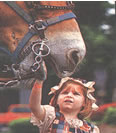
The Ohio Bicentennial Wagon Train stretches across the Blaine Bridge along Rt.40. The wagons traveled throught Blaine on their way to New Paris
Reliving Ohio's Frontier
Travelers try pioneer transportation for bicentennial trek
By Alan Johnson THE COLUMBUS DISPATCH ( June 20, 2003)
MARTINS FERRY, Ohio - With a shout of "Wagons, ho!" Joe Adams of Paul, Idaho, set the Ohio Bicentennial Wagon Train rolling yesterday on a 24-day journey covering 285 miles.
By the time the wagon wheels stop July 14 in New Paris, a Preble County community straddling the Ohio-Indiana border, the wagon train will have crossed Ohio carrying 1,500 people - ranging from 2 months to 91 years old and hailing from as far as Hong Kong and Sweden - on personal adventures of discovery.
Some people are riding for a day or several days; a handful are going for the whole trip.
Ask them why they came - some in wagons, others riding horses or on foot - and the answers are as varied as they were 200 years ago when restless pioneers carved Ohio's path to statehood out of the wilderness of the Northwest Territory.
"It's a chance to see what the land looks like when you're walking and not zipping past in an automobile," responded Celeste Schnabel, a 68year-old Columbus resident who plans to walk most of the route.

Danny Joe Crum and Kimberly Lynn Ostrander came to get hitched - not to a wagon, but to each other. Crum, 40, and Ostrander, 33, both of Cincinnati, dressed in 1800s-period costumes for their wedding yesterday at the Belmont County Fairgrounds at the end of the wagon train's first day's journey of 13.1 miles.
Rev. Homer Harden of the First Presbyterian Church of St. Clairsville rode in on horseback to marry the couple.
"We were planning on getting married anyway," Ostrander said before the ceremony "We weren't going to have the big white wedding anyway. This sounded like fun." A wagon-train wedding has drawbacks, however.
Just as Ostrander was ready to repeat her vows, two mules interrupted with a loud "Hee-haw! Hee-hawl" Everyone laughed, including the wedding party. Then Crum gently wiped a tear from the cheek of his bride-to-be and the ceremony continued.

A signature event celebrating Ohio's 200th birthday this year, the wagon train is sponsored primarily by the Ohio Bicentennial Commission, which contributed $119,000, and the Worthington Bicentennial Committee, which is handling the complicated logistics of an event spanning 10 counties and 99 stops.
The wagon train will be in central Ohio from July 3-6, stopping overnight in Reynoldsburg and New Albany, and rolling through Worthington on July 5 when Gov. Bob Taft will lead the train in the city's bicentennial parade.
The journey began yesterday in Martins Ferry, known historically as the spot where many settlers crossed the Ohio River to begin their long trips westward.
The wagons lined up near Walnut Grove Cemetery, the final resting place of members of the Zane family who opened an Indian trail into a path across southern Ohio known as Zane's Trace.
Phyllis Kane was among the spectators at the cemetery-dedication ceremony held in front of a statue of Betty Zane - Kane's great-great-great-great-grandmother. Betty Zane is credited in history books with helping save Fort Henry - now the city of Wheeling, W.Va. - during a withering attack by the British and Indians in September 1782. The young woman ran from the fort to her father's nearby cabin to replenish a dwindling supply of gunpowder.
"We feel proud of the family," Kane said, "but we didn't brag about it. They say no matter how tall your grandparents are, you have to do your own growing."
Tom Strous, 31, a Worthington school teacher, said he is walking with the wagon train to give him time to think and write in a journal for his students.
"It's not a big deal, walking 12 miles a day," Strous said. "I've been doing living history for the kids. It's something I've been into for several years now."
Along the wagon-train route yesterday - through Bridgeport and Lansing, Blaine and into St. Clairsville - people sat on their porches, on the front steps of stores, in lawn chairs and the hoods of cars. Many waved small American flags. Others shot photos or videotaped the slow-moving procession of 11 wagons.
As for Adams, 68, who traveled 2,200 miles from Idaho for the event, he likes traveling wagon-train style to catch up on the history he missed as a youngster.
"I never sat still in school long enough to learn much history" he said, "so I'm out here doing it."
ajohnson"spatch.com